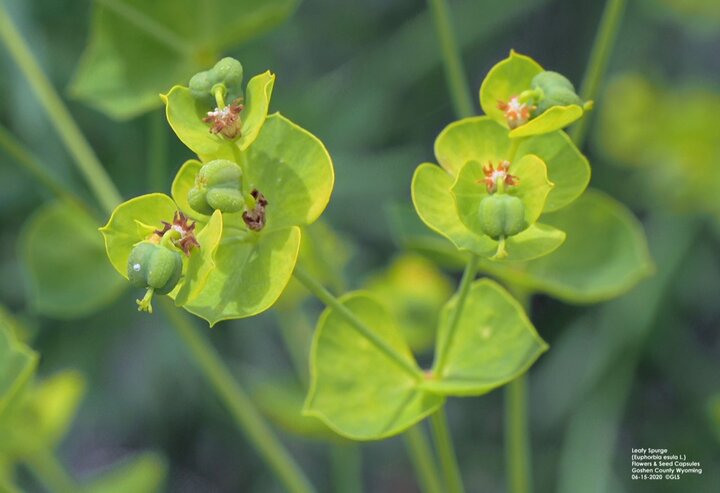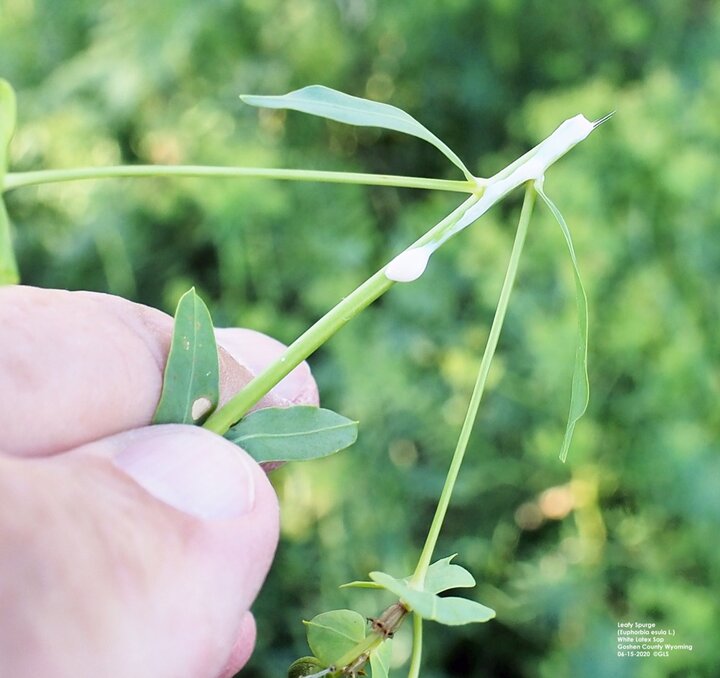Early Detection and Rapid Response (EDRR) is a concept to identify potentially invasive species prior to or just as the establishment of the invasive is taking place. An Integrated Pest Management plan (IPM) can be developed to manage, contain and eradicate the invasive species before it can spread further. This will avoid costly, long-term control efforts.
Leafy Spurge
Leafy spurge is also known as wolf’s milk, faitours-grass or tithymal. Its scientific name is Euphorbia esula L. It is in the family Euphorbiaceae – (Spurge family).
Description
Leafy spurge originated in Eurasia and was introduced into the United States in the early 1800s.
Leafy spurge is a non-native perennial forb. Leafy spurge is not a single species but an aggregation of closely related, perhaps hybridized taxa.
Leafy spurge reproduces from seed and vegetative root buds. It is an erect plant 1 to 3 feet tall with blueish-green leaves with round edges. Flowers are surrounded by heart-shaped yellow-green bracts which hold three round to oblong seeds. Flowers are located in clusters near the top of the plant. Flowers develop in mid-June, but flowering can occur through fall. Each stem produces an average of 140 seeds. When seeds have matured, the plant can “throw” them up to 15 feet from the parent plant. Seed can remain viable in the soil for eight years or more. Seed is spread by birds, animals, people and water. Primary seed germination usually occurs in May. Leafy spurge seedlings develop root buds within 10 to 12 days of emergence. The flower color of Leafy spurge is very similar to Yellow sweetclover and from a distance, both appear similar, so a close inspection is required to make proper plant identification.
Leafy spurge has a very extensive root system. Most of the root system is in the top foot of soil, but the vertical roots may grow to depths of 15 feet or more. This root system contains substantial nutrient reserves which allows the plant to recover from environmental stresses, mowing and other control efforts. The horizonal root system of the plant can spread 15 feet from the crown each year. The woody roots have numerous buds that are capable of producing new shoots.
Leafy spurge contains a white milky latex in all parts of the plant. This latex substance distinguishes Leafy spurge from other weeds when in the vegetative growing stage. The plant also contains a toxic substance that serves as an irritant, emetic and purgative when consumed by livestock. It has caused death in cattle, sheep and loss of hair and inflammation on the feet of horses. However, sheep and goats can graze Leafy spurge as part of their diet, as a form of cultural control of the plant.





Habitat
Leafy spurge is found primarily in rangeland, pastures, waste areas, roadsides and tree rows. It can also be found in riparian areas, making management options limited. The plant can be found in cultivated areas but does not tolerate intensive tillage. However, small root sections can produce new plants and these small root sections can survive drying in a hot sun for two to three hours.
Leafy spurge shoots emerge early in spring from the crown, outcompeting desirable plants for nutrients and water. Infestations in rangeland and pasture can result in a decrease of carrying capacity of livestock by 50 to 75 percent, due to a loss of grass production.
Management
Leafy spurge is a designated noxious weed under the Nebraska Department of Agriculture’s Noxious Weed Program. Prevention is the best and cheapest management option. Having well-established perennial grasses and forbs on a maintained pasture or rangeland with proper grazing and rotational grazing techniques can go a long way to prevent its establishment. Scouting, monitoring and proper identification are key factors for management. Infestations of this weed can occur very rapidly. Several different management options (IPM) will need to be utilized to manage this weed.
There are numerous biological control methods available at this time, which have shown to have varied efficacy. There are root-feeding beetles – Aphthona cyparissiae, A. flava, A. czwalinae, A. lacertosa and A. nigriscutis. There is also the foliar feeder spurge hawkmoth (Hyles euphorbiae), a gall midge (Spurgea esulae), and a stem-boring beetle (Oberea erythrocephala). Selection of any of these insects for use will depend on the leafy spurge release site, some insects do better in some areas than others and prefer different soil types. Before considering any of these biological control insects, contact your local department of agriculture for guidelines and sources.
Grazing with goats or sheep can provide an alternative to herbicides for controlling Leafy spurge. Grazing will reduce top growth but will not control the plant completely. Use of grazing animals is better suited to areas where herbicides cannot be used effectively. Grazing or stocking rates and timing will vary with the infestation site, density and precipitation.
Cultural control measures include fire, mowing, competitive grass species and properly timed cultivation. Fire and mowing can reduce top growth and help limit seed production. Cultivation works best in cropland areas. A number of perennial grasses can be competitive and help control Leafy spurge. These competitive grass species can vary by region, so check with your local agronomist or state agency to see what species will work best in your area.
There are numerous chemical treatment options available to manage Leafy spurge. Products containing dicamba, imazapic, picloram (Restricted Use), glyphosate (non-selective) and 2,4-D have been shown to work. Combinations and application rates of these products may produce better long-term results. Spray site location will dictate what products can be utilized. Grazing restrictions will vary according to herbicide selection.
Spring applications work best when Leafy spurge true flowers are developing in June. Fall applications work best when new regrowth takes place in early to mid-September. Selection of a particular herbicide may dictate when the best time to apply that product. Consult with your local weed management organization or state weed control agency to see which herbicide products will work best in your situation.
The addition of a non-ionic surfactant to the herbicide mix will aid in control. A single application of an herbicide will not control Leafy spurge long-term. Annual re-treatment is necessary until over 90 percent control is achieved. Monitor regrowth and make additional applications as needed. Be sure to select a product labeled for the site. Read, understand and follow all label instructions when using any pesticide.
Nebraska Extension Publications has a number of publications on spurge management and other invasive species. These publications and much more are found at http://extensionpubs.unl.edu/. Search “spurge” or “invasive”.
References
Beck, K.G., “Leafy Spurge”, Colorado State University, Fact Sheet 3.107
Lym, R.G., “Integrated Management of Leafy Spurge”, North Dakota State University, W-866
Lym, R.G. and Messersmith, C.G., “Leafy Spurge, Identification and Chemical Control”, North Dakota State University, W-765
Sandell, L.D. and Knezevic, S., “Noxious Weeds of Nebraska Leafy Spurge”, University of Nebraska, EC174
